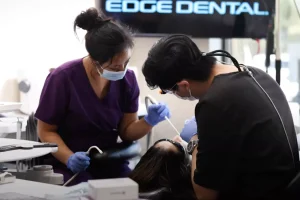Wisdom teeth removal is one of the most common dental procedures that people undergo in their late teens or early twenties. Despite being a routine treatment, many patients wonder how long the recovery takes and what they can expect during the healing process. If you’ve recently had or are planning a wisdom teeth extraction, understanding the timeline of recovery and how to care for your mouth afterward is essential for a smooth and comfortable healing journey. At Edge Dental, we aim to help patients recover quickly and comfortably after any oral surgery procedure.
What Happens During Wisdom Teeth Extraction?
Before discussing the recovery timeline, it helps to understand what actually happens during wisdom teeth extraction. Wisdom teeth, also known as third molars, typically appear between the ages of 17 and 25. However, many people don’t have enough space in their jaw to accommodate these teeth properly, leading to impaction, misalignment, or infection.
During the extraction, your dentist or oral surgeon will first numb the area with local anesthesia or sedation to ensure you feel no pain. The procedure involves making a small incision in the gum tissue and, in some cases, removing bone around the tooth before extracting it. Stitches may be used to close the incision, and gauze is placed to control bleeding.
While the surgery usually takes less than an hour, the healing process takes a bit longer and varies from person to person depending on factors such as age, health condition, and the complexity of the extraction.
How Long Does the Recovery Take?
The recovery time from wisdom teeth extraction typically ranges from one to two weeks. However, the initial healing of the gum tissue can happen within a few days, while complete bone recovery may take a few months. Here’s a general breakdown:
- First 24 Hours: You can expect some bleeding, swelling, and mild discomfort. This is your body’s natural response to healing. Rest is crucial during this period.
- Days 2–3: Swelling often peaks and then begins to subside. Applying an ice pack can help reduce inflammation.
- Days 4–7: The discomfort begins to decrease, and soft foods like yogurt, soup, and mashed potatoes are recommended.
- Weeks 2–3: The gums start to close completely, and most patients feel normal again. You can gradually return to your regular diet.
At Edge Dental, we provide aftercare instructions to ensure you recover safely and quickly. Most patients can resume normal daily activities within two to three days but should avoid strenuous exercise for at least a week.
What Can Affect the Recovery Time?
Recovery varies from one patient to another. Several factors can affect how long it takes your mouth to heal after wisdom teeth extraction:
- Complexity of Extraction – Impacted or partially erupted wisdom teeth often require a longer recovery time compared to simple extractions.
- Age and Health – Younger patients usually heal faster, while those with existing health conditions or slower healing rates may take longer.
- Post-Surgery Care – Following your dentist’s instructions, such as maintaining oral hygiene and avoiding hard foods, can greatly speed up recovery.
- Smoking or Alcohol Use – These habits can delay healing and increase the risk of complications like dry socket.
- Diet and Hydration – Consuming soft, nutritious foods and staying hydrated can promote quicker healing.
If you follow proper care guidelines and maintain a healthy lifestyle, you can expect a smoother and faster recovery period.
What Are the Common Symptoms After Wisdom Teeth Extraction?
It’s normal to experience some post-surgery symptoms after a wisdom teeth extraction, including:
- Mild pain or discomfort around the extraction site
- Swelling or puffiness in the cheeks
- Slight bleeding for the first 24 hours
- Stiffness or soreness in the jaw
- Difficulty opening your mouth wide
These symptoms are temporary and usually subside within a few days. However, if you experience severe pain, excessive bleeding, or signs of infection like fever or pus, contact your dentist immediately.
How to Speed Up the Healing Process?
While your body naturally heals over time, there are several things you can do to promote faster recovery and minimize complications:
- Follow Post-Op Instructions: Your dentist will provide detailed care guidelines—follow them closely.
- Use Ice Packs: Apply ice for 15 minutes on and off during the first 24 hours to reduce swelling.
- Stick to Soft Foods: Eat foods like smoothies, mashed potatoes, or scrambled eggs. Avoid hot, spicy, or crunchy foods.
- Maintain Oral Hygiene: Rinse gently with warm salt water after 24 hours to keep the area clean without disturbing the healing site.
- Avoid Smoking or Using Straws: Suction can dislodge the blood clot and cause a painful dry socket.
- Take Prescribed Medication: Use painkillers or antibiotics as prescribed to manage discomfort and prevent infection.
At Edge Dental, we ensure every patient receives personalized aftercare advice to help them heal as quickly and comfortably as possible.
When Can You Return to Normal Activities?
Most patients can return to work or school within two to three days after wisdom teeth extraction, provided they avoid heavy physical activity. If your job involves manual labor, it’s best to take a few extra days to rest. You should also avoid vigorous exercise for about a week to prevent complications.
As the extraction site heals, you can slowly reintroduce your regular foods and activities. Remember, patience is key—pushing yourself too soon could delay healing or cause discomfort.
Can Invisible Aligners for Teeth Be Used After Wisdom Teeth Extraction?
Yes, but with proper timing. Many patients who have undergone wisdom teeth extraction later consider invisible aligners for teeth to improve their smile alignment. It’s essential to wait until your mouth has fully healed before starting any orthodontic treatment.
Using invisible aligners for teeth too soon after surgery could irritate your gums or slow the healing process. Typically, dentists recommend waiting at least four to six weeks after extraction before beginning aligner therapy. Once healed, aligners can help close small gaps and align your teeth perfectly for a confident smile.
Why Is It Important to Remove Wisdom Teeth?
Not everyone needs to remove their wisdom teeth, but in many cases, extraction becomes necessary to prevent oral health problems such as:
- Crowding or Misalignment – When there isn’t enough space, wisdom teeth can push nearby teeth out of position.
- Infection or Decay – Partially erupted teeth are difficult to clean, leading to gum infection or cavities.
- Cysts or Damage to Nearby Teeth – Impacted wisdom teeth can damage the roots or surrounding bone.
Removing problematic wisdom teeth early can prevent pain, infection, and future orthodontic issues—especially if you’re planning to use invisible aligners for teeth later on.
Final Thoughts
Recovering from wisdom teeth extraction takes patience, proper care, and professional guidance. Most patients heal within one to two weeks, but full recovery can vary depending on the individual. By following your dentist’s aftercare instructions, maintaining good oral hygiene, and giving your body time to heal, you’ll be back to normal in no time.
At Edge Dental, our goal is to make every dental procedure as comfortable and stress-free as possible. Whether you need a safe and effective wisdom teeth extraction or are considering invisible aligners for teeth to enhance your smile, we are here to guide you every step of the way. With our expert care and modern dental techniques, you can look forward to a faster recovery and a healthier, more confident smile.





